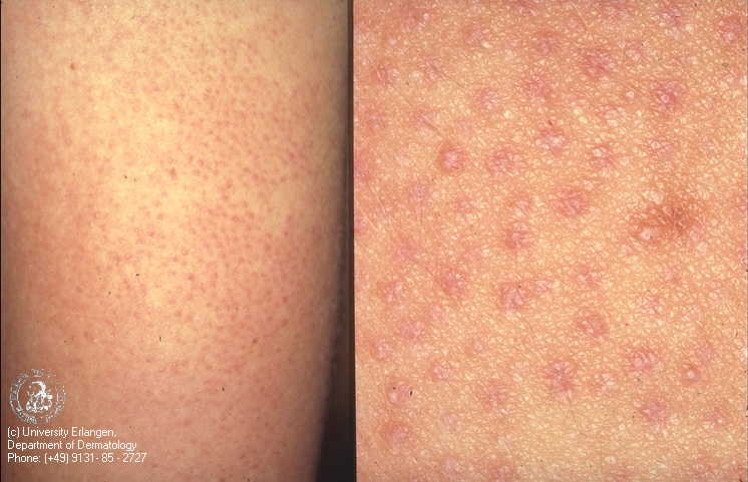DRY SKIN for older kids
What is it?
Dry skin also goes by the names of: Atopic Dermatitis, Eczema, and Seborrheic Dermatitis; they are all the same thing. Dry skin looks like pinkish red, thickened, inflamed patches of skin that itch. As it gets more severe it can ooze a yellow-clear body fluid. Dry skin generally occurs on the face (cheeks, eye brows, around mouth), head (aka cradle cap), elbows, knuckles, torso, knees and outer surfaces of the upper arms and legs. Occasionally it takes the form of skin-colored to pink-red hard bumps the size of pin-heads especially on the outer surfaces of the upper arms and thighs (aka Keratosis Pilaris). It can also occur on the hands and feet of children who sweat there excessively. Many people mistake the dry skin on the feet as athlete’s foot, but athlete’s foot is in the creases of the toes, while dry skin is on the flat exposed under surface.
What causes it?
Dry skin is like an allergic reaction to anything that dries out or irritates the skin. There is definitely an inheritance pattern, but some kids have it without either parents having it, and some kids don’t have it when both parents have it. The exact cause is unknown, but it is not contagious.
How common is it?
Most white children will have a form of the rash for at least a brief period. It is much more common in white than blacks and Asians.The exact incidence is unknown.
What worsens it?
Anything that dries, irritates, or damages the skin will make it worse. Drying soaps, scrubbing the skin, washing excessively, hot water, abrading the skin when drying, scratching, and sometimes laundry detergents, will start, or worsen, a case of dry skin.
How do we treat it?
Basically, you should avoid things that irritate the skin (prevent), moisturize (to prevent and treat), and then consider topical anti-inflammatory medications (steroids). Occasionally, we use anti-itch medicines or antibiotics.There is also a distinct difference between prevention and treatment. Most of the following are preventive measures. The treatment will not work without the prevention.
- Wash the child as frequently as you want. Some recommend washing more frequently, and some less frequently. Some children respond better to more washing, and some to less washing. If one isn’t working, then try the other. It is much more important that you follow the rules about washing correctly given below.
- Use comfortably cool water instead of hot, as the heat destroys the natural oils that protect the skin.
- Pour a couple of tablespoons of MINERAL OIL in the bathtub and wisk it in (this acts as a moisturizer).
- Use a moisturizing soap or no soap. Generally, stick with unscented DOVE SENSITIVE, TONE or CETAPHIL.
- Never use bubble bath.
- Don’t use wash cloths, or at least use them gently, as abrasion worsens dry skin.
- Let the child play as long as he / she wants.
- Pat the skin dry, or air dry, rather than rubbing.
- Put on a good moisturizer WITHIN 3 MINUTES of getting out of the tub. The skin will dry out after 3 minutes. This seals in moisture rather than covering up dry skin. By good moisturizer, we mean avoid the baby lotions, use: CUREL, KERI, LUBRIDERM, EUCERIN, CETAPHIL, or AQUAPHOR. Cevere seems to be the4 one favored by most Dermatologists.
- Where the dry skin is worse, use the ointment (thick and greasy) moisturizers (extra strength hand versions of the above brands) as ointments are stronger.
- Use Cortaid (hydrocortizone or prescription topical steroids if given those) when the dry skin flares up.
- Use an over the counter triple antibiotic ointment, if the dry skin is severe or is oozing a yellow substance, and call if it does not improve with the triple antibiotic.
- If the child scratches the rash, then it will worsen it; therefore, use oral Benedryl to help relieve the itch, and keep the finger nails short. Also, avoid sweating as this may worsen the itch.
- Avoid wool or synthetic fabrics; use cotton instead.
- Foods generally don’t cause dry skin, but avoid foods you feel may worsen the rash.
- Saliva does worsen dry skin about the mouth and on the abdomen and chest where drool hits. A thin layer of vaseline in these areas acts as a moisturizer and treats the dry skin.
- If doing the above isn’t enough, then you should call the office during business hours to make an appointment.
When should I call the doctor?
If the above plan does not work
If the dry skin looks infected
If the skin is painful
If the child can’t stop scratching it even with Benedryl
When should we see a specialist?
A pediatrician can handle the vast majority of cases of dry skin. Most pediatricians will have a limit for how much medicine they will prescribe, how severe the case is, or if there is another problem associated with the illness, and once we reach that limit we will usually offer a referral. Most routine referrals to a Dermatologist take several months; therefore, we have learned to handle more and more with experience.
Will this go away with age?
About 25% of those who still have dry skin will improve or be cured at these ages: young childhood, pre-adolescence, and then adulthood. Therefore, most children with dry skin will not have it as an adult. Generally, the more severe cases will last longer.
Keratosis Pilaris
Keratosis pilaris is the name for those white bumps that people with dry skin get on the outer upper surfaces of the arms, thighs and sometimes the cheeks. They are a special type of dry skin where the outer (keratin) layer of skin thickens. You can prevent them with the above measures, but they usually won’t get rid of them. Topical steroids (Cortaid or Rx if one was given) will sometimes reduce the bumps but usually not by much. Lactic acid is the best therapy for them. Lactic acid acts to dissolve away the bumps and is a moisturizer. It occasionally stings when it first goes on if they have been picked but not much. Brand names of 5% lactic acid are AmLactin, Epilyt or Lacticare (also known as Ammonium Lactate).
A special note about FEVER BLISTERS
Since dry skin is actually a break in the skin, it makes a skin infection much more likely to occur. Fever blisters (herpes labialis) can invade the dry skin patch and cause a significant and painful infection. Once you get a fever blister infection in a location (like the lip, fingers, cheeks), then it may come back in that area over and over again.

